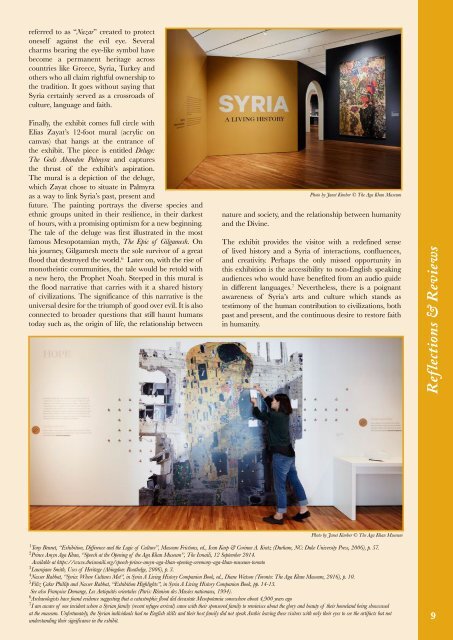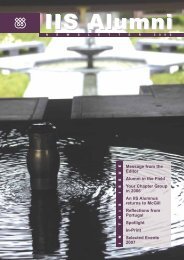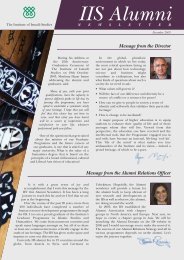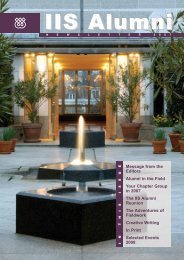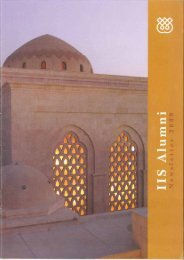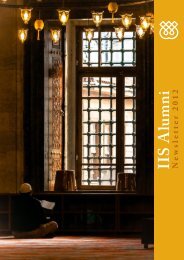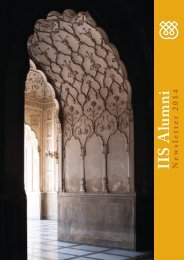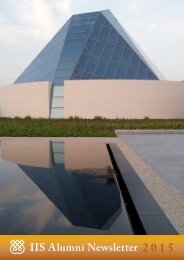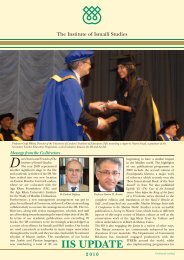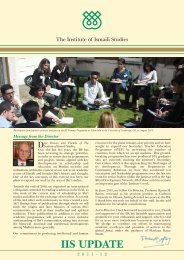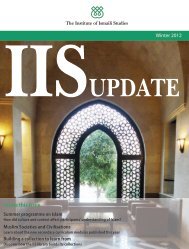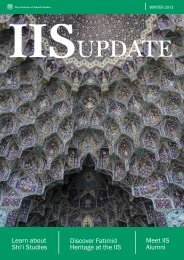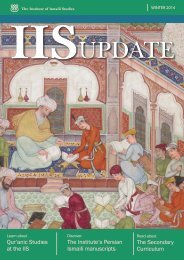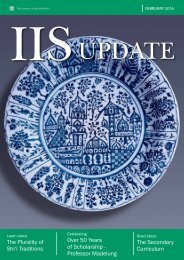IIS Alumni Booklet 2016
Create successful ePaper yourself
Turn your PDF publications into a flip-book with our unique Google optimized e-Paper software.
eferred to as “Nazar” created to protect<br />
oneself against the evil eye. Several<br />
charms bearing the eye-like symbol have<br />
become a permanent heritage across<br />
countries like Greece, Syria, Turkey and<br />
others who all claim rightful ownership to<br />
the tradition. It goes without saying that<br />
Syria certainly served as a crossroads of<br />
culture, language and faith.<br />
Finally, the exhibit comes full circle with<br />
Elias Zayat’s 12-foot mural (acrylic on<br />
canvas) that hangs at the entrance of<br />
the exhibit. The piece is entitled Deluge:<br />
The Gods Abandon Palmyra and captures<br />
the thrust of the exhibit’s aspiration.<br />
The mural is a depiction of the deluge,<br />
which Zayat chose to situate in Palmyra<br />
as a way to link Syria’s past, present and<br />
future. The painting portrays the diverse species and<br />
ethnic groups united in their resilience, in their darkest<br />
of hours, with a promising optimism for a new beginning.<br />
The tale of the deluge was first illustrated in the most<br />
famous Mesopotamian myth, The Epic of Gilgamesh. On<br />
his journey, Gilgamesh meets the sole survivor of a great<br />
flood that destroyed the world. 6 Later on, with the rise of<br />
monotheistic communities, the tale would be retold with<br />
a new hero, the Prophet Noah. Steeped in this mural is<br />
the flood narrative that carries with it a shared history<br />
of civilizations. The significance of this narrative is the<br />
universal desire for the triumph of good over evil. It is also<br />
connected to broader questions that still haunt humans<br />
today such as, the origin of life, the relationship between<br />
Photo by Janet Kimber © The Aga Khan Museum<br />
nature and society, and the relationship between humanity<br />
and the Divine.<br />
The exhibit provides the visitor with a redefined sense<br />
of lived history and a Syria of interactions, confluences,<br />
and creativity. Perhaps the only missed opportunity in<br />
this exhibition is the accessibility to non-English speaking<br />
audiences who would have benefited from an audio guide<br />
in different languages. 7 Nevertheless, there is a poignant<br />
awareness of Syria’s arts and culture which stands as<br />
testimony of the human contribution to civilizations, both<br />
past and present, and the continuous desire to restore faith<br />
in humanity.<br />
Reflections & Reviews<br />
Photo by Janet Kimber © The Aga Khan Museum<br />
1 Tony Bennet, “Exhibition, Difference and the Logic of Culture”, Museum Frictions, ed., Ivan Karp & Corinne A. Kratz (Durham, NC: Duke University Press, 2006), p. 57.<br />
2 Prince Amyn Aga Khan, “Speech at the Opening of the Aga Khan Museum”,The Ismaili, 12 September 2014.<br />
Available at https://www.theismaili.org/speech-prince-amyn-aga-khan-opening-ceremony-aga-khan-museum-toronto<br />
3 Laurajane Smith, Uses of Heritage (Abingdon: Routledge, 2006), p. 3.<br />
4 Nasser Rabbat, “Syria: Where Cultures Met”, in Syria A Living History Companion Book, ed., Diane Watson (Toronto: The Aga Khan Museum, <strong>2016</strong>), p. 10.<br />
5 Filiz Çakır Phillip and Nasser Rabbat, “Exhibition Highlights”, in Syria A Living History Companion Book, pp. 14-15.<br />
See also Françoise Demange, Les Antiquités orientales (Paris: Réunion des Musées nationaux, 1994).<br />
6 Archaeologists have found evidence suggesting that a catastrophic flood did devastate Mesopotamia somewhere about 4,900 years ago<br />
7 I am aware of one incident where a Syrian family (recent refugee arrival) came with their sponsored family to reminisce about the glory and beauty of their homeland being showcased<br />
at the museum. Unfortunately, the Syrian individuals had no English skills and their host family did not speak Arabic leaving these visitors with only their eyes to see the artifacts but not<br />
understanding their significance in the exhibit.<br />
9


